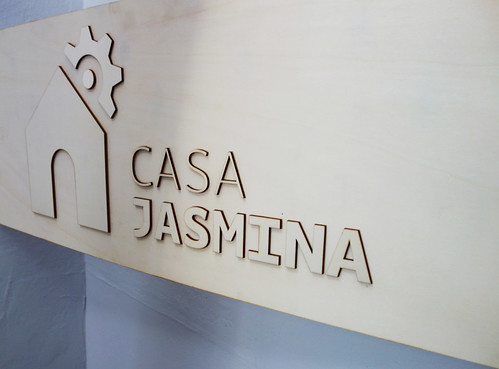 We lived in the open source connected home of the future. And survived.
We lived in the open source connected home of the future. And survived.
When I learned about Casa Jasmina (CJ), a connected open source home of the future that Bruce Sterling and Jasmina Tesanovic are building with a part of the Ardunio team – namely Lorenzo Romagnoli, Davide Gomba and Massimo Banzi – I knew I wanted to see it.
(Michelle and I, sitting side by side at Bruce’s ThingsCon closing keynote literally looked at each other and said: Let’s go!)
So Michelle, Alexandra and I got to go – and happened to be the very first official guests: A tremendous honor and privilege, and also a responsibility to kick it off well, contribute and reflect; if we can start a few good traditions there, all the better.
Here are some notes, thoughts, questions and impressions from these last few days, typed up quickly on the way back from Torino to Berlin. Unsorted, a bit rough around the edges, as behooves the project itself, while the impressions are still fresh.
Firsts
As we’re the very first “official” guests at CJ, what can we contribute? How can we help? Which traditions can we start?
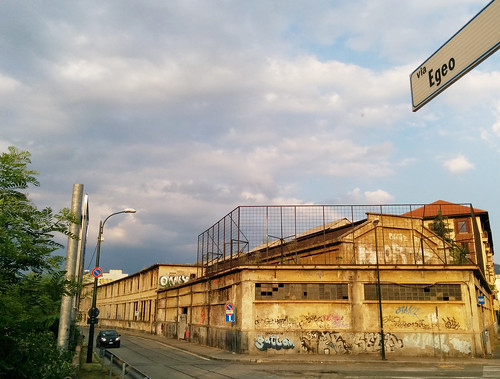 The (formerly) abandoned factory complex that Casa Jasmina, FabLab Torino, the Arduino HQ and coworking space ToolBox are built in.
The (formerly) abandoned factory complex that Casa Jasmina, FabLab Torino, the Arduino HQ and coworking space ToolBox are built in.
Casa Jasmina is a home first, connected second
CJ is much more of a home already than I had expected – and much less connected. As of now, as far as I know, there’s only two art projects with any “smarts” built in. (We added Good Night Lamp alongside a couple of books.) This makes much more sense to me than installing a tech show room that’s fully outfitted with smarts; the smarts should emerge organically as residents add things matching their needs and desires rather than moving the people into a giant apartment-shaped computer.
CJ is a home first, connected second. And that’s a good thing.
Let a thousand casas bloom
CJ taps into local culture, tradition and strengths, namely Torino’s industrial design heritage as well as its location right at the epicenter of the open source hardware ecosystem, the place where Arduino was invented (and for a long time, built).
As Michelle pointed out, a smart home like this comes with assumptions baked in. How would people live here? Who would they be? For example, would it be home for a European-style small family or a couple rather than a three-generation household? To draw from true diversity, it’d be great to build plenty of local Casa Jasminas around the globe, each tapping into local cultures, assumptions and ways of life. Taken together, they’d become a platform of distributed R&D and learning.
Future materials
Currently, the future (of interior design at least) is made of plywood. With some of Torino’s thinking and skills behind it, what other materials will become easier to manufacture open source? What other aesthetics will it allow for? Can (should?) open design get a more “finished” look & feel? Team CJ started out with state of the art fabbed plywood furniture, but it’s quite clear they want to explore beyond that, to take it to the next level. This is going to be exciting to watch as lots of open source furniture designs still tend to either aim for easy/cheap production or for exploring new concepts. “High end” feel exists in the open design movement (check out Ronen Kadushin’s Italic Shelf as a great example), but it’s still rare. However, there’s nothing inherent in open source design that necessitates a plywood look; it just happens to be relatively cheap and easy to process, and has a very cool rough look to it.
Ground rules in the connected home
A connected home (like an urban environment) will need to signify the ground rules: Are sensors monitoring your movements? Cameras? Is sound being recorded? Will your devices work or be blocked? What happens to data relating to you once you leave?
 Ethical Things by Simone Rebaudengo
Ethical Things by Simone Rebaudengo
One solution/hack might be to come up with a set of words/icons that communicate what kind of rules are in effect in each room/zone. For example, the entrance zone might be more “heavy handed” in its scanning, with RFID scanners, wifi sniffers or cameras; the kitchen might have voice controlled appliances that would necessarily constantly be listening for input (like an Xbox or Amazon Echo today); the bedrooms might be completely sensor free zones. It’s important to manage expectations and reduce anxieties once more connectivity and sensors enter our personal space.
Or maybe, this kind of information should be more granular, on the appliance/device level. At the very least this should include ways they sense: Does it listen or watch? Does it share data to the cloud?
![]() Some possible connected device engagement icons. Source: Noun Project (eye by Thomas Le Bas, ear by Søren Michelsen, cloud by Aaron K. Kim).
Some possible connected device engagement icons. Source: Noun Project (eye by Thomas Le Bas, ear by Søren Michelsen, cloud by Aaron K. Kim).
Does it allow for haptic/touch/voice input? Does it require active engagement or is it happy to do its thing passively?
Finding a workable language for these things (both in the more immediate sense of words/icons and in the conceptual sense) is a pretty clear design challenge. This will no doubt evolve over time.
How to engage with the connected home of the future?
That last point of engagement is worth stressing. What are desirable engagement models? What kind of engagements should rather be avoided?
What not to do/build/sense is easily as important as what to.
How to engage (or make engageable) is a challenge at CJ on at least three levels:
- How can you know/communicate how to engage with each object? Right now, there aren’t many connected objects there yet. This will change soon, and quickly. Soon the place might be brimming with connectivity, and a lot of it will be new, explorative, bleeding edge stuff. It’ll be pioneering work to navigate the space, to make sense of it.
- How do you explain the background of the objects? Give credit for artworks, tell the stories about tables, shelves, the connected geiger counter art on the wall? How can you do that without turning the place into a museum full of plaques, or an advertising spread full of QR codes?
- How do you set a framework for the kind of interventions that are possible and wanted at the place? What’s OK to hack, what’s better left alone? After all, this could range from making a plant tweet (certainly OK) to hacking the dish washer to measure its energy use (probably OK) to firing up a chain saw and attack the fabbed furniture (maybe not so OK).
Who has root privileges in your home?
A key question in a connected home is that of access & power: Who has read access to this home? Who has write access? Who has root privileges?
- Consider an assisted living scenario: Does the inhabitant or the care facility have the final say in which door opens when, and control the oven?
- Consider corporate housing: If you live in corporate housing permanently, or a client puts you up in one of their apartments while you’re on a gig with them, what’s tracked, and who can analyze that data?
And what about physical and data permanency?
This applies much more to temporary housing, from Airbnbs to Casa Jasmina. For a hotel room the assumption is that it undergoes a “factory reset” when the guest leaves: It’s put back to its original state as much as possible. In an Airbnb situation, the guests can alter and adapt the space temporarily, but would take great care to ensure they can put everything back the way it was before. (The effect is similar to that of the hotel room, only the responsibilities are distributed differently.)
In a space like Casa Jasmina, of course, more permanent changes are not just endured but encouraged – it’s a place to be hacked. But what about data permanency? Will data stay behind? Should it? Which type, and how?
For now, that’s a question we don’t face in many places (outside the Internet, of course, that is). But increasingly, as homes get smarter and more connected, this will become A Thing. If I can get to a hotel room or Airbnb and it syncs with my user profile of, dunno, mood lighting and music and window blinds preferences and what have you, and if the smart mattress measures my heartbeat throughout my stay, will that data leave with me, will the room/home’s data be wiped? Can I choose not to record anything at all, or to leave my data imprint on a place? These types of questions are going to be interesting to figure out, and Casa Jasmina is in a better position than any other place I know.
An open letter to the next guests
One example of a small act of engagement and setting of framework: We arrived late Sunday night, when Lorenzo let us in, gave us a quick tour and was off – we were on our own, trying to figure out what’s in the space, what to do, what not to do. Which right now was very straight forward: It’s a nice loft-ish apartment that felt right at home (not least of all because many of the things and references in there come from shared friends of ours, like a copy of the #iotmanifest launched at ThingsCon, and an Ethical Thing by Simone Rebaudengo). I expect if you arrived a year from now, the experience will be very different.
However, the next morning, Bruce and Jasmina swung by – and just like in an Airbnb, there was a moment where everybody seemed to think: Is this your home? Or ours? Who’s the guest, who’s the host? Jasmina and Bruce stressed how important it is to them that residents make it their home. Everything is up for use and consumption.
As a mini intervention, we figured as first guests it might be more socially acceptable to pass this on to the next guests. So we wrote a letter to the next guests of Casa Jasmina (GitHub letter repository). (Yes, it’s on Github. Where else would it be?) A few words about our experiences, some survival tipps like where to find breakfast in the morning. Hopefully this turns into a bit of a tradition: Something to connect one visitor with the next, and everybody with CJ. Who knows, maybe it even might serve as data for some future research.
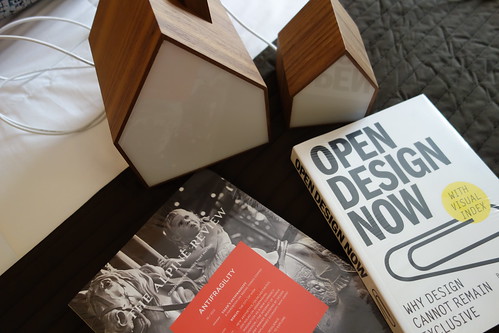 House-warming gifts: A family of Good Night Lamp, Open Design Now and Alpine Review
House-warming gifts: A family of Good Night Lamp, Open Design Now and Alpine Review
A SCRUM board for Casa Jasmina
Trying to find the best way to collect ideas, challenges & improvement ideas, we set up a SCRUM board for Casa Jasmina. The most straight forward way to go about it is a physical SCRUM board with post-it notes, on the side of a kitchen cupboard. That way it’s easy to add things, discover ideas, and start working on one or two. But in order to also get a digital archive and log book, some sort of sync would be great. There are some interesting hacks out there, like this one, but we figured some fuzziness is ok: It doesn’t have to procuce a perfect log book. So we set up a CJ repository on GitHub that should at some point connect to a Little Printer to sync from digital to paper; but it’ll also be possible to add directly to the board (this would not sync back unless someone comes up with an elegant or fun way to do that).
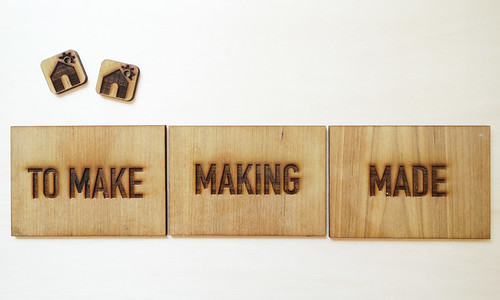 A scrum board for Casa Jasmina in the making
A scrum board for Casa Jasmina in the making
 A scrum board for Casa Jasmina in the making
A scrum board for Casa Jasmina in the making
Torino IoT Meetup
The team also organized an IoT meetup on short notice. Up on the rooftop, despite the sweltering record heat of this Torino summer afternoon, a crowd of maybe 30 people turned up to discuss the role of open source and design and ethics around smart homes. Bruce moderated a discussion of Alex, Michelle, Jasmina and I.
And let me tell you, this crowd that gathered there, on the rooftop of this former factory of Arduino and coworking space and FabLab and open source connected home of the future is one switched on crowd that knows to ask the right questions. I was particularly happy to see a strong presence of interaction designers there, as they are one of the key groups who will be designing these very interactions we keep talking about, and face a plethora of ethical challenges.
We ended up not giving presentations as a conversation seemed much more interesting in that moment, but I had drafted some notes before to structure my thoughts. (And since “drafting notes” means “markdown” for me, my presentation tool Deckset automagically turns this into some slides.). So here are my (largely uncommented) slides that can give you a bit of an idea of the angles from which I approached the discussion:
Lots to think about
The conversations of the last two or three days triggered a wave of thoughts for how to approach the concept of connected homes. I’ll be thinking about this for a while.
Certainly more to write about this soon. Also, it’s a good reminder to examine the interaction models for connected homes some more, here and also at Interaction16. I hope we can come back in maybe a year to see how Casa Jasmina has evolved, been drenched in connectivity, grown some teeth – and led to some truly valuable and surprising insights.
For now, I want to thank our lovely kind hosts for the most excellent days we spent at Casa Jasmina, and the great group of people we got to meet there. Thank you!
Ps. Michelle also has a great write-up of our stay, as does the Casa Jasmina blog, and on my Flickr, you can find plenty of photos.


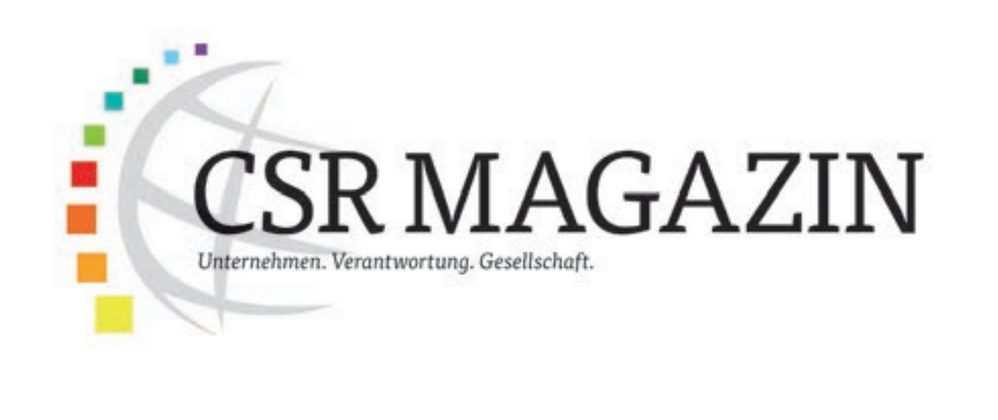
4 Comments
Hey Peter, great post.
Re: “How do you explain the background of the objects?”
Have the host tell you, as before? Though it’s somewhat harder to identify the “story-worthy” objects. And asking about every piece will probably tire the host. Maybe some guests do not even want to know, as this can reduce your comfort. Experienced that in an Airbnb where the host was using a WeMo presence sensor – to switch on the light, I thought. Then I found out he also gets (remote) notifications…
“without turning the place into […] an advertising spread full of QR codes?”
Stick the QR codes to the back?
Kind regards, Thomas
Yeah, all good points. It’s not trivial, from a curatorial point of view – and it might get harder down the road, once these things are not in this clearly “marked” exploratory space/lab. Going to be interesting to figure out ways to handle this gracefully, without overly taxing the host, without putting too much of a burden on the guest, and without being too intrusive/heavy handed. A light weight, granular, fluid approach.
*Hmmm. Prosecco is a “lightweight granular fluid.”
Hah!